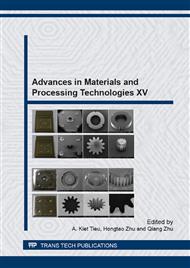p.287
p.293
p.312
p.319
p.325
p.339
p.348
p.355
p.365
Niobium Containing Advanced High Strength Steels for Automotive Applications – Processing, Microstructure, and Properties
Abstract:
Two major drivers for the use of advanced steels in the automotive industry are fuel efficiency and increased safety performance. Fuel efficiency is mainly a function of weight of steel parts, which in turn, is controlled by gauge and design. Safety is determined by the energy absorbing capacity of the steel used to make the part. All of these factors are incentives for the automobile manufacturers to use Advanced High Strength Steels (AHSS) to replace the conventional steels used to manufacture automotive parts in the past. AHSS is a general term used to describe various families of steels. The most common AHSS is the dual-phase steel that consists of a ferrite-martensite microstructure. These steels are characterized by high strength, good ductility, low tensile to yield strength ratio and high bake-hardenability. Another class of AHSS is the complex-phase or multi-phase steel which has a complex microstructure consisting of various phase constituents and a high yield to tensile strength ratio. Transformation Induced Plasticity (TRIP) steels is another class of AHSS steels finding interest among the U.S. automakers. These steels consist of a ferrite-bainite microstructure with significant amount of retained austenite phase and show the highest combination of strength and elongation, so far, among the AHSS in use. High level of energy absorbing capacity combined with a sustained level of high n value up to the limit of uniform elongation as well as high bake hardenability make these steels particularly attractive for safety critical parts and parts needing complex forming. A relatively new class of AHSS is the Quenching and Partitioning (Q&P) steels. These steels seem to offer higher ductility than the dual-phase steels of similar strengths or similar ductility as the TRIP steels at higher strengths. Finally, martensitic steels with very high strengths are also in use for certain parts. The most recent initiative in the area of AHSS is the so-called 3rd Generation AHSS. These steels are designed to fill the region between the dual-phase/TRIP and the Twin Induced Plasticity (TWIP) steels with very high ductility at strength levels comparable to the conventional AHSS. Enhanced Q&P steels may be one method to achieve this target. Other ideas include TRIP assisted dual phase steels, high manganese steels and higher carbon TRIP type steels. In this paper, some of the above families of advanced high strength steels for the automotive industry will be discussed with particular emphasis on the role of niobium.
Info:
Periodical:
Pages:
325-335
Citation:
Online since:
November 2013
Authors:
Keywords:
Price:
Сopyright:
© 2014 Trans Tech Publications Ltd. All Rights Reserved
Share:
Citation:


